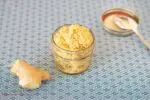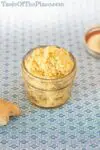Description
Having ginger paste on hand can be a game-changer in the kitchen. It’s fresh, all-natural, easy to make, and saves the hassles of having to mince or grate fresh ginger every time you need it.
Ingredients
- 8 ounces fresh ginger
- 2 to 4 tablespoons (1 to 2 ounces) neutral flavored oil, plus more for drizzling (optional, see notes)
Instructions
- Wash the fresh ginger and remove any bad or dried-out spots. Peeling the ginger is optional. If the skin seems tough or dried out, give it a peel.
- Cut the ginger against the grain into thin slices.
- Throw it in a blender along with 2 tablespoons of the oil, and give it a whirl for a minute or two, scraping down the sides as needed, until you achieve a paste-like consistency. If the paste seems overly dry, add the remainder of the oil and continue blending. If you are not using oil, you will likely need to add a bit of water to help with the blending.
- Transfer it to a glass jar, smoothing out the surface of the paste, then drizzle enough oil on top to cover with a thin layer. This will help keep the air out and to better preserve the garlic paste. I’ve found that fresh ginger paste may need an oil top-off on the second day. Whenever you use some of the paste, be sure to smooth the surface and top with a bit more oil. Simply skip this step if you are omitting the oil.
- Ginger paste made with oil will keep in the fridge for up to two weeks, while ginger paste made with water should be used within a few days.
Notes
I’ve found that most ginger paste recipes suggest using a neutral flavored oil, like canola oil so that the oil doesn’t affect the taste of the paste. However, I personally prefer to use olive oil for almost everything, including in my ginger paste. It’s really up to your personal taste!
To keep your ginger paste fresh and flavorful, it’s best to store it in an airtight container in the fridge. To help preserve the paste, add a layer of oil on top as a protective barrier. Be sure to use it up within two weeks or throw it away if it develops mold, off flavors, or colors. For longer storage, you can freeze ginger paste in a silicone ice cube tray and then transfer the cubes to a zip-top bag in the freezer. Another option is to scoop the paste into a zip-top bag, press it into a thin layer, remove excess air, and seal it before freezing. This way, you can easily break off pieces of frozen ginger paste when you need it.
Looking for a recipe to use up any extra ginger paste? Try this Mango & Pineapple Chutney from Curaçao. Yumm!
Quick tip: One inch of raw ginger is equal to about one tablespoon of ginger paste.
- Prep Time: 15 minutes
- Category: Condiment

